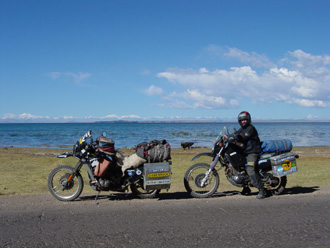Inca Paradise
We climbed steeply out of the valley and soon found ourselves at 4000m. The XT was not amused and started spluttering again, we took the cover off the air intake and that helped. With not too many forms to fill in and plenty of people ready to point us in the right direction.
Entering Peru was easier than leaving Chile, but we were used to that by now, the Chileans seem reluctant to let you leave, wonder why?
We spent our first night in the small town of Moquegua, away from the coast for a change. The next morning we changed our plans for the umpteenth time and instead of riding north towards Arequipa and Lima, we headed back up into the mountains towards Puno and Lake Titicaca. We climbed steeply out of the valley and soon found ourselves at 4000m. The XT was not amused and started spluttering again, we took the cover off the air intake and that helped. The road went up to over 5000m and although we had to go slowly both bikes made it. Celebrated by buying lunch from one of the roadside shacks that lined the road at a junction. The wasnt a menu, no choice either, just a bowl of thick soup with many unidentified objects floating around welcome to the culinary delights of Peru! In the countryside anyway.
Bypassing the town of Desaguadero, close to Bolivia, we got our first sight of Lake Titicaca, over a hill, round a curve and there it was in front of us. More blue and dazzling than I thought it possibly could be.
First sight of Lake Titicaca
We followed the lake as we rode to Puno and watched the sun disappear behind the mountains as we reached the town. There was a huge choice of places to stay, each eager for our custom. A big change from Chile, where it was sometimes a problem to find a place, that didnt mind a couple of dirty motorbikes parked on their patio. Bikes and kit safely under lock and key, it was time to explore.
Had to leave the bikes behind for a day or two, so we could visit some of the islands in the lake. Not far from Puno are the floating islands of Uros. Made of reeds, these islands really float, must be strange living on such a small space, especially with boatloads of tourists arriving every morning to have a gawk.
The floating islands of Uros.
We spent the night on the peaceful island of Amantani, an island with no police, no dogs, no traffic, no electricity and not too many tourists.
Back on the mainland, Arno spent a morning taking the carbs on both bikes apart, putting copper wire in the nozzles so they should run better. We left Puno and Lake Titicaca behind and rode towards Cusco, stopping along the way at Sillustani to see the towers that the Colla tribe built in which to bury their dead.
Our bikes were running a lot better than before and even the pass of La Raya at 4300m didnt cause any problems.
La Raya Pass, 4300m
As we descended, the scenery changed again as we rode into the valleys, towards Cusco. Terraces covered the hillsides, in use since before the Incas were around, and the fields were full of crops, irrigated by a maze of water channels.
After a couple of days in Cusco, we rode to Ollantaytambo and caught the train to Machu Picchu from there. It was one of the highlights we had really been looking forward to and it didnt disappoint. We didnt do the Inca Trail, too much like hard work if you ask me and damn expensive to boot. Instead we climbed Huayna Picchu, the mountain overlooking the site and got an amazing view, then spent the rest of the day wandering around the maze of buildings and plazas.
Machu Picchu, from the mountain behind
We left Aguas Calientes the next morning at the crack of dawn, the train, the carriages crammed with Inca Trail porters carrying the most amazingly huge loads and kids on their way to school. We decided to spend a few more days in Ollantaytambo as there was a festival going on. The place was full of people from the neighbouring villages having a great time and drinking large amounts of the local home brew chicha. Unfortunately I spent the whole time either in bed or on the toilet, suffering from a serious bout of Incas Revenge.
Villagers arrive for the festival in Ollantaytambo
After a dose of antibiotics, we got back to Cusco, without having to stop by every bush along the way. We did stop at a couple of interesting Inca ruins though.
After a week, exploring the city, visiting a number of museums and markets, it was time to head back towards the coast and investigate the strange lines in the sand at Nazca.
Attracting a crowd in the Plaza de Armas, Cusco.
The road down to Nazca is now almost all paved, with the exception of a few places where the bridges have been washed away, and strangely, in any decent sized town, where the tarmac stops on the outskirts, only to start again where the buildings stop. A couple of passes over 4000m, spectacular scenery and changeable weather, make it a good 2 day ride. We stayed the night in Abancay, hoping to meet a couple of other riders, should have ridden further though, the next day was a long, hard ride!






